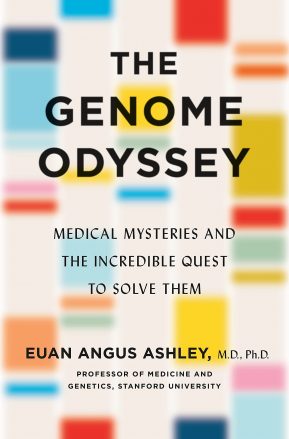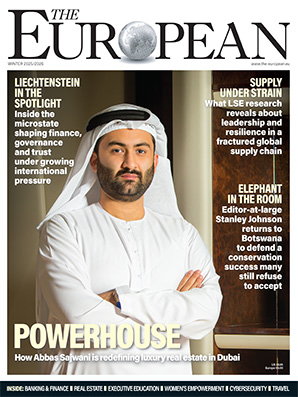The future of genetic medicine

Today, we live in a genome world, and that’s good news for everyone, as Dr Euan Ashley, author of new popular science book The Genome Odyssey, explains.
I stared at the paper issuing from the patient monitor. The wavy lines indicated a heart rate of 220 beats per minute and a heart rhythm incompatible with life.
My patient was, thankfully, unaware as we charged the defibrillator to try to reset her heart. “Clear!”. The shock convulsed her body briefly, restoring normal rhythm. But that normal rhythm, a heart rate of 40 beats per minute, was sadly too slow for her failing heart. I swallowed the lump in my throat as I started to explain to her distraught relatives the implications of the thick heart, the small electrical waves, and the abnormal rhythms we had witnessed. The tears were hard to suppress as I explained there were no treatments for this condition. We couldn’t save her.
Unbeknownst to us that grief-stricken night, a few thousand miles away a few green shoots of hope were emerging. The patient had suffered from amyloidosis, a disease where proteins get misfolded, kind of like the body’s cells losing the instructions for their own molecular origami. The misfolded protein, which is called ‘amyloid’, builds up in tissues around the body causing, among other things, a thick heart prone to electrical abnormalities. You might have heard of amyloid since it is thought to play a role in the early stages of Alzheimer’s disease. The lack of treatments for amyloid has been dogma in medicine since 1922 when the red staining of amyloid by the textile dye Congo red was first discovered by German pathologist Hans Bennhold.
Just a few days after the patient’s death, in a stunning advance, researchers from the Boston-based biotechnology company Intellia (one of whose co-founders, Jennifer Doudna, won the Nobel Prize in Chemistry in 2020 for contributing to the discovery of CRISPR gene editing in bacteria) released results on six patients with a form of amyloid disease. They had tested for the first time in humans a gene-editing approach to reduce the amount of transthyretin, a protein that can lead to a build-up of amyloid. The results were spectacular. Among the six patients tested, the reductions in transthyretin protein were 52% for the lower dose and an astounding 87% for the higher dose group.

That work is the latest breakthrough in the science of the genome. What began as the Human Genome Project—a 10-year, 10-country, multi-billion dollar project to spell out (sequence) the letters of just one human genome—is now both one of the fastest growing areas of biotechnology and a medical subspecialty where practitioners not only read the genome to diagnose disease but also write the genome to actually treat it.
Most of our success in reading the human genome to date has come from the world of rare disease. Most people don’t realize that rare diseases are collectively rather common—about as common, in fact, as diabetes. Yet so many patients and families toil with the torment of a disease with no name, an affliction with no expert physicians, no family support group, and no treatment. They spend years going from doctor to doctor trying to find answers, a journey that has become known as a “medical odyssey”.
At Stanford, we are part of an international group of medical detectives who try to end these odysseys, taking on the hardest cases in medicine—medical mysteries that no one else has been able to solve.
The most powerful tool in our armoury? The genome. Six billion letters—each of them either an ‘A’, ‘T’, ‘G’ or a ‘C’—can now be sequenced for around $500, an unprecedented drop from the $3billion with which the Human Genome Project was funded. To put this in perspective, if a Ferrari had dropped in price as much as human genome sequencing has then it would cost around one penny.

And the genome is powerful. When families turn to our undiagnosed diseases network, often having spent years exhausting all their financial and emotional resources, we are able to solve the mystery almost 40% of the time. We also calculated that bringing the genome earlier in the medical journey, ending the medical odyssey earlier, could save a whopping 94% of medical costs. Because of findings like these, countries around the world are now adopting genomic sequencing in their health care systems to help diagnose rare disease.
It isn’t just human genomes we can sequence, either. The most fundamental technology of the Covid-19 pandemic has been genome sequencing: not the six billion DNA bases of our human genome but the 30,000 RNA bases of the coronavirus genome. Within hours of the novel coronavirus sequence being released, diagnostic tests based on that sequence were being developed in countries around the world. Just weeks after the code was in the public domain, and building on decades of foundational science, genomic vaccines—like those from BioNTech/Pfizer, NIH/Moderna, and Oxford/AstraZeneca—were designed, synthesised, and ready for testing.
Sequencing the virus has also allowed us to track its spread as well as its evolution towards new variants. Booster vaccines based on the sequences of the new variants are already in trials. Sequencing pathogens is the key to controlling future pandemics. Indeed, we urgently need to establish an international biosurveillance task force focused on emerging threats, leveraging sequencing and genomic science so we can be ready for the next pandemic before it even begins.
The genome will allow us to move from reactive medicine, where we act after a disease manifests, to proactive, preventive health care where we understand the diseases for which we are most at risk and act to prevent their emergence. In the future, even our smartwatches will use knowledge of our genome to fine tune their diagnostics to detect abnormal heart rhythms predisposing to stroke or to movement disorders like Parkinson’s disease.

In The Genome Odyssey: Medical Mysteries and the Incredible Quest to Solve Them, Dr Euan Ashley reveals the science behind genetic medicine breakthroughs and the personal stories of patients who have benefitted from this new era of medical treatments.
Most excitingly, the future will see advances in the science of gene editing, allowing us to cure genetic diseases at source. In the last few years, major breakthroughs for diseases like haemophilia, sickle cell disease, retinal diseases, or debilitating diseases like spinal muscular atrophy have emerged. Even common diseases might be approachable one day too. Large-scale studies like All of Us in the United States and the UK Biobank allow us to study the health and genetic data of entire populations, allowing us to identify those rare individuals resistant to disease. Using knowledge of the genomes of these resilient ‘superhumans’ we can start to find therapies that can make everyone a little more resistant to disease. As I recently discussed in the Daily Mail, we could even see the emergence of combination vaccines based on the genetic codes of such superhumans that provide simultaneous, long-term protection against three of the top 10 killer diseases—heart disease, stroke, and Alzheimer’s disease—within the next 10 to 15 years.
This genome world, where we can learn our risks, get ahead of disease, adopt treatments that can make us more disease resistant—a world where I have fewer conversations that end with the words “Sorry, there’s nothing more we can do”—is a world I look forward to living in.
Dr Euan Angus Ashley is Associate Dean and Professor of Cardiology and Genetics at Stanford University in California. His book The Genome Odyssey: Medical Mysteries and the Incredible Quest to Solve Them (St. Martin’s Press) is out now on Amazon in hardcover, eBook, and audiobook formats, priced £22.99, £9.49, and £20.47 respectively. For more information visit www.genomebook.info.


